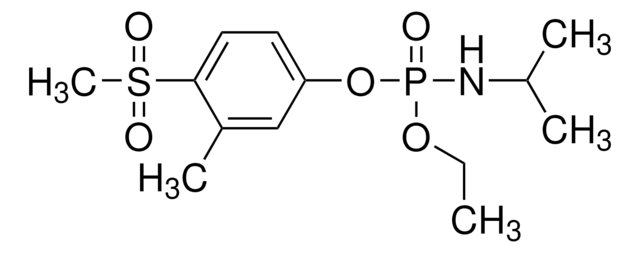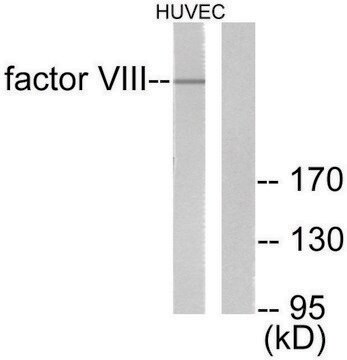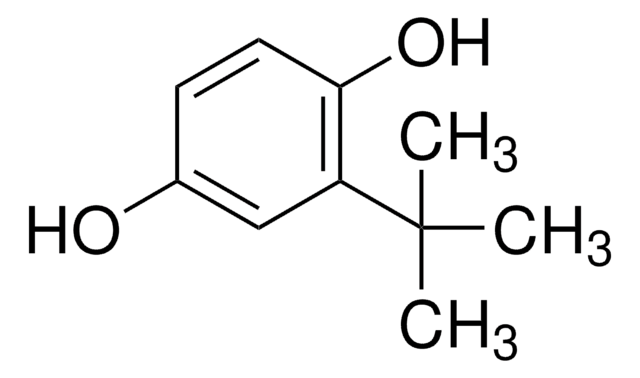W218308
Butylated hydroxyanisole
99%, FCC, FG
Sinonimo/i:
2(3)-t-Butyl-4-hydroxyanisole, 2(3)-t-Butylhydroquinone monomethyl ether, BHA
About This Item
Prodotti consigliati
Origine biologica
synthetic
Livello qualitativo
Grado
FG
Fragrance grade
Halal
Kosher
agenzia
follows IFRA guidelines
Conformità normativa
EU Regulation 1223/2009
EU Regulation 1333/2008 & 178/2002
FCC
FDA 21 CFR 117
FDA 21 CFR 172.515
Densità del vapore
6.2 (vs air)
Saggio
99%
Temp. autoaccensione
599 °F
Punto di fusione
58-60 °C (lit.)
applicazioni
flavors and fragrances
Documentazione
see Safety & Documentation for available documents
Allergene alimentare
no known allergens
Allergene in fragranze
no known allergens
Organolettico
mild
InChI
1S/C11H16O2/c1-11(2,3)9-7-8(13-4)5-6-10(9)12/h5-7,12H,1-4H3
MRBKEAMVRSLQPH-UHFFFAOYSA-N
Cerchi prodotti simili? Visita Guida al confronto tra prodotti
Categorie correlate
Descrizione generale
Applicazioni
- Inhibition of NADPH oxidase 2 enhances resistance to viral neuroinflammation by facilitating M1-polarization of macrophages at the extraneural tissues.: This study examines the potential neuroprotective effects of butylated hydroxyanisole (BHA) in modulating immune responses during viral infections of the nervous system, suggesting BHA′s utility in reducing neuroinflammation through macrophage modulation (Choi et al., 2024).
- Highly Sensitive Electrochemical Determination of Butylated Hydroxyanisole in Food Samples Using Electrochemical-Pretreated Three-Dimensional Graphene Electrode Modified with Silica Nanochannel Film.: This study presents a novel method for detecting BHA in food products, emphasizing its role in food safety and quality control, and showcasing advanced material use for enhanced analytical performance (Huang et al., 2024).
- Purification and identification of novel antioxidant peptides derived from Bombyx mori pupae hydrolysates.: While focusing on antioxidant peptides, this research also contextualizes the antioxidant market where BHA is prominently used, underscoring the ongoing search for natural and effective alternatives in food and pharmaceutical industries (Chukiatsiri et al., 2024).
Indicazioni di pericolo
Consigli di prudenza
Classi di pericolo
Aquatic Chronic 2
Codice della classe di stoccaggio
11 - Combustible Solids
Classe di pericolosità dell'acqua (WGK)
WGK 2
Punto d’infiammabilità (°F)
241.9 °F - Pensky-Martens closed cup
Punto d’infiammabilità (°C)
116.6 °C - Pensky-Martens closed cup
Dispositivi di protezione individuale
Eyeshields, Gloves, type P3 (EN 143) respirator cartridges
Scegli una delle versioni più recenti:
Possiedi già questo prodotto?
I documenti relativi ai prodotti acquistati recentemente sono disponibili nell’Archivio dei documenti.
I clienti hanno visto anche
Il team dei nostri ricercatori vanta grande esperienza in tutte le aree della ricerca quali Life Science, scienza dei materiali, sintesi chimica, cromatografia, discipline analitiche, ecc..
Contatta l'Assistenza Tecnica.







